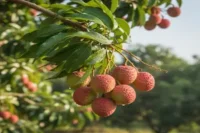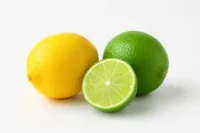Jalapeno Growth Stages Unveiled: A Comprehensive Guide Seed to Harvest
Published: 11 Oct 2025
Jalapenos are one of the most popular chili peppers grown in home gardens. They start small and green but go through several stages before reaching their spicy, mature form. In this guide, we will look at the jalapeno growth stages from seed to harvest. You will learn what the plant looks like at each step, how long each stage lasts, and the care it needs to grow healthy and full of flavor.
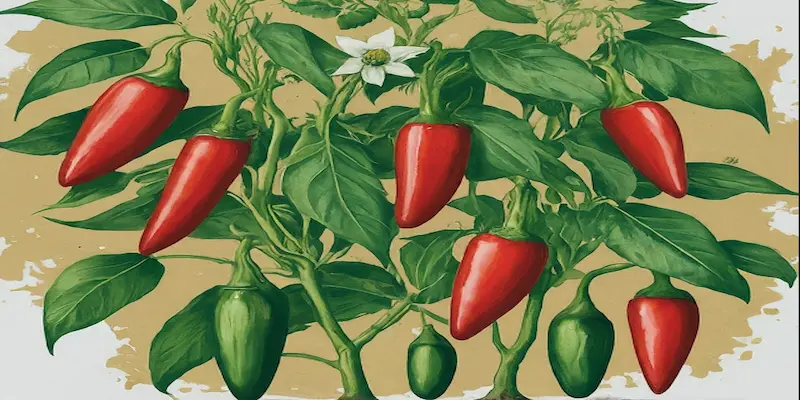
Jalapeno Scoville
The Scoville scale is a measurement system used to quantify the spiciness or heat level of chili peppers and other spicy foods. It’s named after its creator, Wilbur Scoville, who developed the scale in 1912. The heat is measured in Scoville Heat Units (SHU), which indicate the amount of capsaicin—the chemical compound responsible for the spicy sensation—present in the pepper
Jalapeño peppers typically range from 2,500 to 8,000 Scoville Heat Units (SHU) on the Scoville scale, which measures the spiciness or heat of chili peppers and other spicy foods. This makes jalapeños milder than hot peppers like habaneros or ghost peppers but still provides a noticeable kick. The heat level can vary depending on factors like growing conditions and ripeness, with mature, red jalapeños usually spicier than their green counterparts.
Seed Germination
The seed germination stage is the very first step in growing jalapeno plants. This is where the tiny seeds start their journey to becoming spicy peppers. To begin, plant your jalapeno seeds in warm, moist soil. Jalapeno seeds need warmth, so placing them on a sunny windowsill or under a grow light is ideal.
In about 7 to 14 days, you’ll see little green sprouts, called seedlings, popping up through the soil. This means your jalapeno seeds have successfully germinated. During this time, keep the soil moist but not too wet, as too much water can cause the seeds to rot. Also, ensure the seedlings get plenty of light to help them grow strong.
Germination is a delicate process, but with some care and patience, your jalapeno seeds will sprout within 7 to 14 days, ready to continue their journey into healthy plants. Once they have a few sets of leaves, they’re ready for the next stage of growth
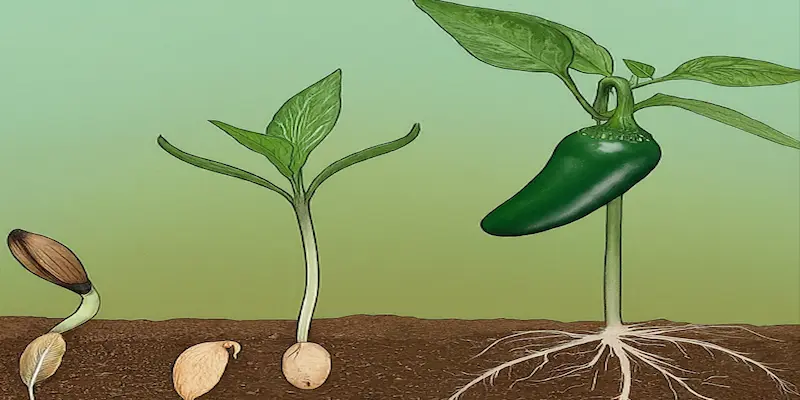
Seedling Stage
Once the jalapeno seeds have germinated, they enter the seedling stage. Several features mark this stage:
1. The first appearance of seedlings is a delightful moment for any gardener. These tiny sprouts have two seed leaves that feed the plant until true leaves appear.
2. The care instructions during the seedling stage include regular watering and maintaining a temperature between 70°F and 80°F. It’s also essential to provide them with ample sunlight or artificial grow lights for at least 16 hours daily.
3. The seedling stage lasts about 2 to 3 weeks. During this time, the seedlings develop their first set of true leaves.
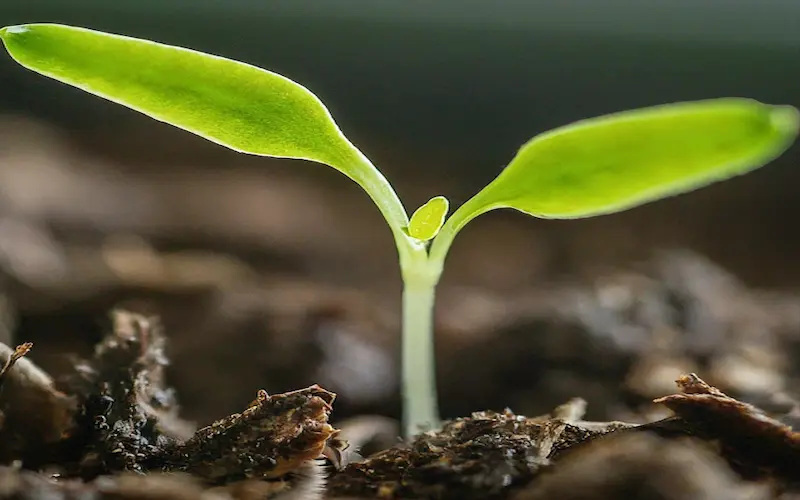
Vegetative Stage of Jalapeno Growth Stages
Characteristics of the Vegetative Stage
Once the jalapeno seedlings have developed their true leaves, they transition to vegetative. During this stage, the jalapeno plant focuses on growing in size and strength; the leaves become more extensive, and the stem thickens.
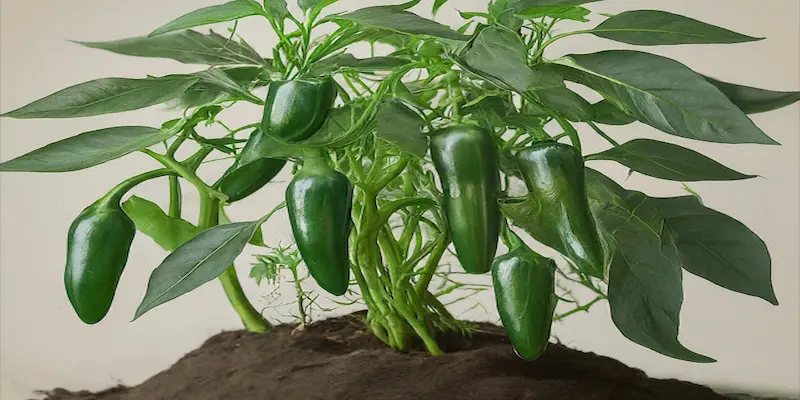
Nutritional Needs
The nutritional needs of jalapenos vary during each growth stage. The plant requires more nitrogen during the vegetative stage to support its rapid growth.
Pruning and Training Techniques
Pruning during the vegetative stage can help the jalapeno plant grow bushier and more productive. Training your plants using methods like staking or caging can support their growth.
Duration of Vegetative Stage
The vegetative stage can last between 4 and 6 weeks. During this period, you can observe your jalapeno plant growing and becoming stronger each day.
Jalapeno Fertilizer
Fertilizing your jalapeno plants is key to growing strong and productive peppers. Here’s what you need to know about choosing and using fertilizer for your jalapenos:
Why Fertilize Jalapenos? Fertilizer provides essential nutrients that your jalapeno plants need to grow and produce peppers. These nutrients include nitrogen (N), phosphorus (P), and potassium (K), often referred to as NPK. Each nutrient plays a specific role:
- Nitrogen promotes leafy growth and strong stems.
- Phosphorus supports root development and flower formation.
- Potassium helps with overall plant health and fruit quality.
Choosing the Right Fertilizer For jalapenos, look for a balanced fertilizer that provides equal parts nitrogen, phosphorus, and potassium. A general-purpose fertilizer with an NPK ratio of 10-10-10 or 20-20-20 works well. You can also use fertilizers specifically formulated for vegetables or peppers.
How to Apply Fertilizer
- Timing: Start fertilizing your jalapeno plants a few weeks after they’ve been planted or transplanted. Continue feeding them every 4 to 6 weeks during the growing season.
- Application Method: Follow the instructions on the fertilizer package for the correct amount to use. You can apply fertilizer directly to the soil around the plants or use a liquid fertilizer to water the plants.
- Avoid Over-Fertilizing: Too much fertilizer can harm plants and lead to excessive leaf growth with fewer peppers. Stick to the recommended amounts to avoid problems.
Organic Alternatives If you prefer organic options, consider compost or well-rotted manure. These natural fertilizers enrich the soil with nutrients and improve its structure. You can also use organic fertilizers like fish emulsion or seaweed extract.
Monitoring and Adjusting: Pay attention to your jalapeno plants. Adjust your fertilization routine as needed if they show signs of nutrient deficiencies—like yellowing leaves or poor fruit development. By using the right fertilizer and applying it correctly, you’ll help your jalapeno plants stay healthy and produce an abundance of spicy, flavorful peppers.
Jalapeno Plant Flowers
The jalapeno flowering is crucial to its lifecycle. It is the bridge between the vegetative stage and the fruit development stage.
As the jalapeno plant matures, it will begin to produce flowers. These flowers are typically small and white, indicating your plant is healthy and progressing correctly.
The pollination process plays a vital role during the flowering phase. For jalapenos, this process is usually facilitated by insects or wind. However, indoor growers can help by gently shaking the plant or using a small brush to transfer pollen from one flower to another.
Successful pollination cannot be overstated. It allows the jalapeno plants to move on to the next stage, fruit development.
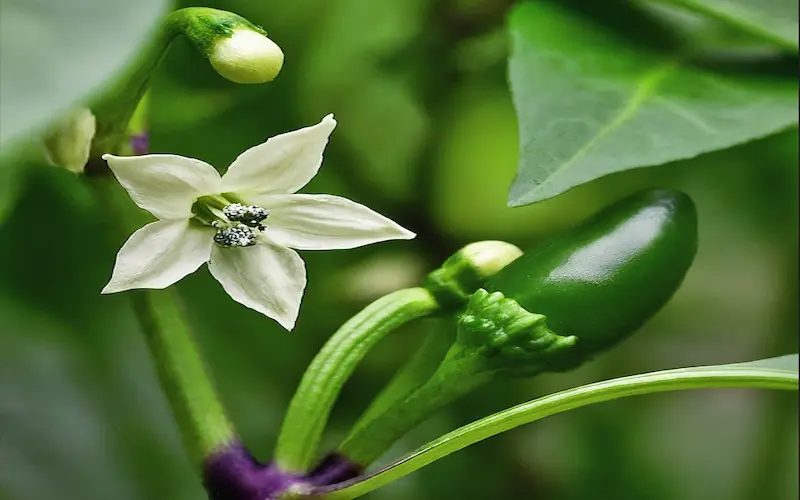
Fruit Development Stages
During the fruit development stage, several changes occur:
- Green jalapeno peppers begin to take shape. Once pollination is successful, the flowers will fade and fall off, leaving behind the early stages of green jalapeno peppers.
- 2. Several factors influence fruit growth, including light, temperature, and watering. A balanced combination of these affects the size and spiciness of the jalapeno peppers.
- 3. Harvesting and preservation methods are crucial during this stage. Typically, jalapenos are harvested when green, but if left on the plant, they will eventually turn red.
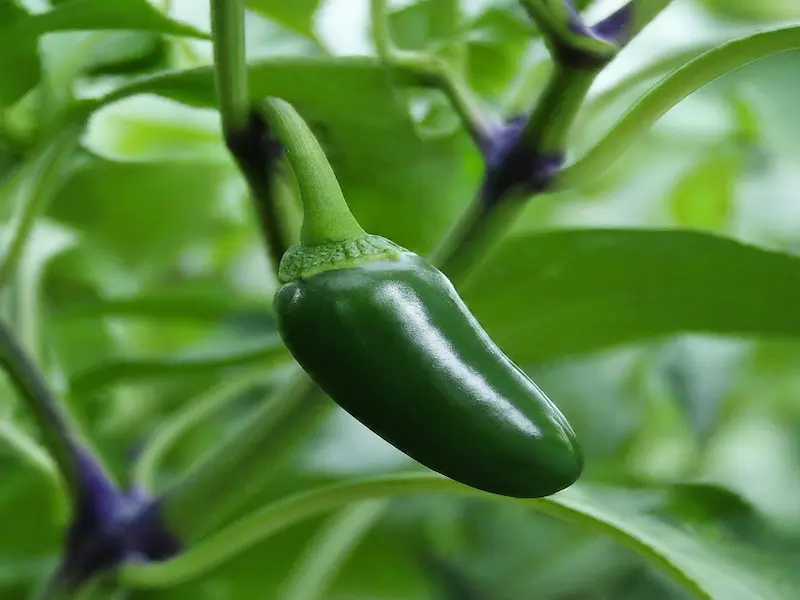
Jalapeno Ripening Stages
“As the jalapeño peppers mature, they transition into the final ripening stage. This is a critical phase where the peppers develop their characteristic spicy flavor, much like the Lisbon lemon tree relies on precise care during its flowering and fruiting stages to produce juicy, vibrant citrus. Monitor both plants closely during these periods—consistent watering, balanced nutrients, and pest control ensure optimal results for your peppers and lemons!”
During the ripening stage, the peppers significantly change color, transitioning from bright green to vibrant red. This color change indicates that the jalapenos are reaching their full spiciness and flavor profile.
When Harvest Jalapeno Peppers
The best time to harvest jalapenos is a matter of personal preference. Some prefer to gather when the peppers are still green and have a milder flavor, while others wait until they are fully ripened and have developed their maximum heat.
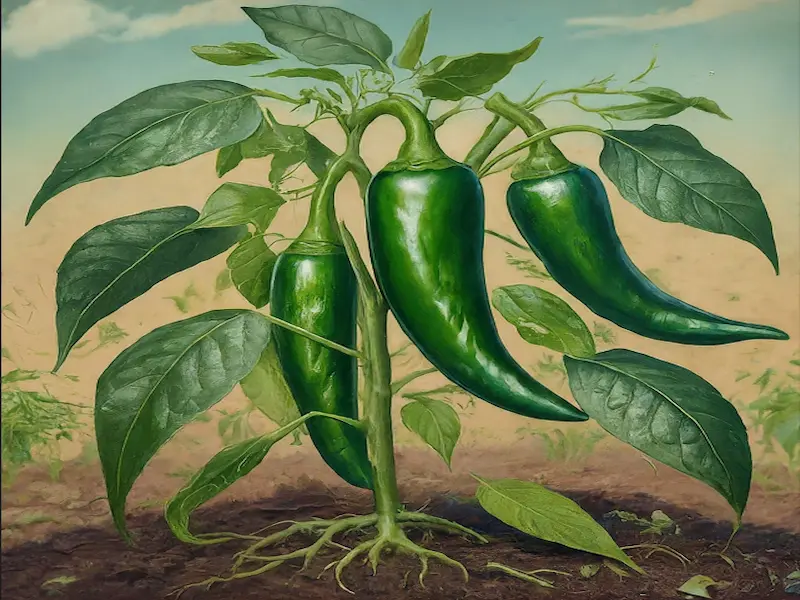
Conclusion
I’ve guided you through the amazing journey of growing jalapeños, from tiny seeds to spicy, flavorful fruits. Knowing these growth stages is key to a successful harvest. Each stage requires specific care, and understanding this can make a big difference in the quality of your jalapeños.
Growing green jalapeños is rewarding. With this knowledge, you’re ready to start your own jalapeño garden. Take care of your plants, enjoy the process, and soon, you’ll enjoy the spicy, delicious jalapeños you’ve grown!
Jalapeno peppers go through several stages of growth, from seed to harvest. Understanding these stages can help you successfully cultivate jalapenos. Here is a comprehensive guide to the growth stages of jalapenos:
1. Seed Germination: The first stage is when the jalapeno seed begins to sprout and develop roots. This typically occurs within 7 to 14 days after planting.
2. Seedling Stage: Once the seed has germinated, it enters the seedling stage. At this point, the plant will grow leaves and establish a more robust root system. Providing adequate light and water during this stage is crucial to encourage healthy growth.
3. Vegetative Growth: During this stage, the jalapeno plant focuses on growing its foliage and branching out. It will continue to develop more leaves and stems, preparing for flower and fruit production. Pruning can be done during this stage to promote bushier growth.
4. Flowering Stage: The flowering stage is crucial as it marks the beginning of pepper production. Small white or yellow flowers will appear on the plant, eventually turning into peppers. Bees and other pollinators are vital in ensuring successful pollination during this stage.
5. Fruit Development: After successful pollination, the flowers will drop, and the pepper pods will start to grow. Initially, the peppers will be small and green, gradually increasing in size and changing color as they mature. Regular watering and proper nutrition are essential during this stage to support healthy fruit development.
6. Harvesting: The final stage is when the jalapeno peppers are ready to be harvested. The exact time for harvesting depends on your preference for pepper maturity. If you prefer milder peppers, you can gather them when they are green. For spicier peppers, allow them to ripen to their full color, usually red. Gently twist or cut the peppers from the plant, not damaging the stem or the plant itself.
By understanding and monitoring these growth stages, you can ensure a successful jalapeno harvest and enjoy the spicy goodness of homegrown peppers.
The jalapeno growth stages can vary, but it takes about 70 to 85 days for jalapenos to grow from seed to harvest. Factors such as weather conditions and care provided to the plants can also influence the growth timeline.

- Be Respectful
- Stay Relevant
- Stay Positive
- True Feedback
- Encourage Discussion
- Avoid Spamming
- No Fake News
- Don't Copy-Paste
- No Personal Attacks



- Be Respectful
- Stay Relevant
- Stay Positive
- True Feedback
- Encourage Discussion
- Avoid Spamming
- No Fake News
- Don't Copy-Paste
- No Personal Attacks


